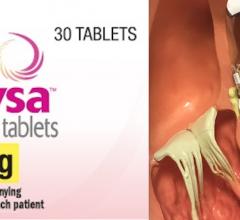
The Boston Scientific Synergy stent uses a unique abluminal, bioresorbable drug-carrier polymer that dissolves after the vessel wall has healed months after the stent is implanted. Stent polymers have been implicated in cases of late-stent thrombosis, which required patients with DES to stay on dual antiplatelet therapy (DAPT). This study looked at using the device as a way to shorten DAPT duration.
May 17, 2020 – A new study sought to reveal whether drug-eluting stents (DES) coated with bioabsorbable polymer (BP) presented a safety advantage without compromising efficacy compared to durable polymer (DP) formulations. Subgroup findings from the TWILIGHT trial were presented during the Society for Cardiovascular Angiography and Interventions (SCAI) 2020 Virtual Conference.
The study examined the Boston Scientific Synergy BP DES platform in a higher risk patient population than previously studied. In addition, the investigators evaluated the effect ticagrelor monotherapy in such patients, which has not been done in previous studies. Ticagrelor is a blood thinner that has been found to prevent stroke, heart attack and other heart problems.
Investigators conducted a pre-specified analysis among patients enrolled in the TWILIGHT trial treated with the BP everolimus-eluting stent (BP-EES) or a DP-DES. Following successful percutaneous coronary intervention (PCI) and three months of ticagrelor plus aspirin, patients were randomized to aspirin or placebo for one year; DES choice was at physician discretion. The primary endpoint was target lesion failure (TLF) [composite of cardiac death, target vessel myocardial infarction (MI), clinically driven target lesion revascularization (TLR) or definite/probable stent thrombosis (ST)].
Patients receiving BP-EES (n = 653; 9.2%) were more frequently randomized in North America and had a lower frequency of prior MI compared to those receiving DP-DES (n = 6404; 90.8%); total stent length was approximately 39 mm in both groups. One-year rates of TLF were 6.4% and 6.1% in the BP-EES and DP-DES groups, respectively (p = 0.72). Analogous rates of def/prob ST and TLR were 0.8 vs 0.9% (p = 0.49) and 5.3 vs 4.4% (p = 0.96). The effect of ticagrelor monotherapy on ischemic and bleeding events was uniform across DES groups (all pint >0.10).
“Our work shows that the Synergy stent performs similarly to other durable polymer DES in relatively high-risk patients enrolled in the TWILIGHT trial,” said Usman Baber, M.D., lead author of the study. “This is a clinically relevant finding as it provides randomized evidence supporting the use of this platform in such patients. In addition, the effect of ticagrelor monotherapy on ischemic and bleeding events observed in the overall trial was preserved among patients receiving a Synergy DES, suggesting this strategy may be a safe alternative in high bleeding risk patients treated with the Synergy stent.”
“These findings broaden the generalizability of adopting a strategy of P2Y12 inhibitor monotherapy to patients treated with different DES platforms,” continued Baber. “In addition, our results provide reassurance that the Synergy platform performs similarly to other newer-generation DES in high-risk patients.”
Find links to the rest of the SCAI late-breaking trials and other SCAI news
Reference:


 August 28, 2023
August 28, 2023 









